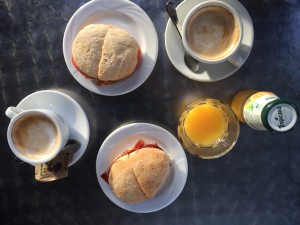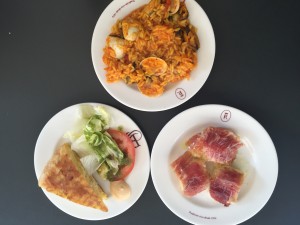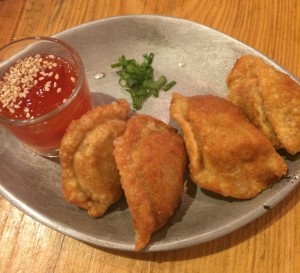 However, I first need to dispel a big misconception of the Spanish diet. Outsiders, myself included before I came here, think that all Spaniards eat are paella, tapas, and churros con chocolate. (I am saddened, but glad, to say that so far I have eaten less churros than I had expected to.) While these three foods can be a big part of their diet, there is so much more.
However, I first need to dispel a big misconception of the Spanish diet. Outsiders, myself included before I came here, think that all Spaniards eat are paella, tapas, and churros con chocolate. (I am saddened, but glad, to say that so far I have eaten less churros than I had expected to.) While these three foods can be a big part of their diet, there is so much more.
Spanish breakfasts are petite, just like the people. A typical meal consists of a small coffee of some sort—like café latte or café con leche—as well as toast with a spread, called tostada con [insert topping here.] If you choose to go out to get breakfast, you can order a coffee, tostada, and even an orange juice for a small price of 2 to 3 euros. Some restaurants offer a coffee and tostada for 1 euro!
Lunches and dinners are a bit bigger and include a variety of different foods. Some traditional ones are tortillas, seafood paella, and jamón ibérico. The tortillas are not what you think they are though; it is a cake-shaped mix of potatoes, onions, eggs, and heaven. If you enjoy seafood, then you have come to the right place because the seafood paella happens to be a specialty in Spain. However, if you are not a fan of seafood, that’s okay because there are plenty of meat options here! Jamón ibérico is one type, similar to prosciutto, and varies in price depending on how the pigs—jamón, aka ham—are fed. Parallel to grass-fed beef in the U.S., Spain has jamón ibérico de bellota, or acorn-fed ham.
 For all you vegetarians, not eating meat is a strange concept for Spaniards but can be accommodated. Other popular foods are croquetas, gazpacho, empanadas, and fried eggplant, all of which can be vegetarian options. Croquetas are deep-fried balls of heaven. They are hard to describe because they taste kind of like potatoes but made the way one would make thick gravy. The gazpacho is a cold tomato-based, thick soup that is very creamy and smooth. Empanadas here are similar to the ones you would imagine from South America, and they can be filled with veggies, meat, fruits, and more. Lastly, fried eggplants are exactly what it sounds like—although one of my favorite ways that they are cooked is with honey!
For all you vegetarians, not eating meat is a strange concept for Spaniards but can be accommodated. Other popular foods are croquetas, gazpacho, empanadas, and fried eggplant, all of which can be vegetarian options. Croquetas are deep-fried balls of heaven. They are hard to describe because they taste kind of like potatoes but made the way one would make thick gravy. The gazpacho is a cold tomato-based, thick soup that is very creamy and smooth. Empanadas here are similar to the ones you would imagine from South America, and they can be filled with veggies, meat, fruits, and more. Lastly, fried eggplants are exactly what it sounds like—although one of my favorite ways that they are cooked is with honey!
 Snacking is absolutely essential for Spaniards, especially since a typical eating schedule for them is: breakfast at 8am, lunch at 2pm, and dinner at 10pm. In between lunch and dinner, if you don’t eat a snack, you could become hangry (hungry + angry) as I do when I haven’t eaten in a while. Called la merienda, Spanish snacking completely differs from American snacking. Instead of crackers or veggie sticks, they opt for coffees with cakes or ice cream at around 5 to 6pm.
Snacking is absolutely essential for Spaniards, especially since a typical eating schedule for them is: breakfast at 8am, lunch at 2pm, and dinner at 10pm. In between lunch and dinner, if you don’t eat a snack, you could become hangry (hungry + angry) as I do when I haven’t eaten in a while. Called la merienda, Spanish snacking completely differs from American snacking. Instead of crackers or veggie sticks, they opt for coffees with cakes or ice cream at around 5 to 6pm.
Anyways, all foodies will absolutely go mad in Sevilla with all the different Spanish foods to try—without stepping way our of their comfort zones. To be completely honest though, I have to admit that Sevilla is not quite there yet when it comes to providing good foods from many other cultures because it is Spaniards making what they think is a culture's food. For example, my roommates and I have been craving Mexican food since we have been abroad, so we decided to check out a Tex-Mex place by our house, and after eating there, we now crave *good* Mexican food. To give you an idea of what was passed off as "Tex-Mex" food, we ordered tortilla chips and were given BBQ chips--need I say more?
 With that being said, the traditionally Spanish dishes fail to disappoint and make up for the lack of diversity and skill in other cultural foods. My two pieces of advice are to avoid
With that being said, the traditionally Spanish dishes fail to disappoint and make up for the lack of diversity and skill in other cultural foods. My two pieces of advice are to avoid
touristy areas because the food is not as good there and to really attempt to get into the Spanish food schedule because when you go out for food during those times, you will really get the full experience of seeing locals out and about.
Fun Fact #1: One way to tell if a restaurant is good is if the floor is littered with dirty used napkins. In Sevilla, this is a sign that the restaurant is so busy that it doesn’t have time to clean the floor, so if you ever see a place that looks like this, it’s worth a try!
Fun Fact #2: The churros con chocolate pictured above is from La Chocolatería, on the street Virgen del Lujan--absolute best in the city.
Cynthia Hara is the Fall 2015 CEA MOJO Blogger in Seville, Spain. She is currently a junior at California Polytechnic State University, San Luis Obispo.








